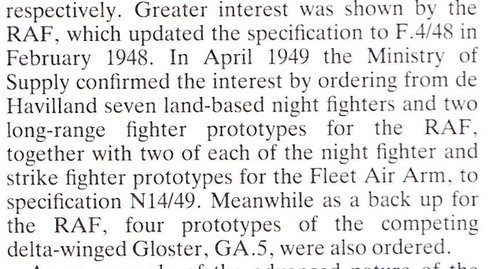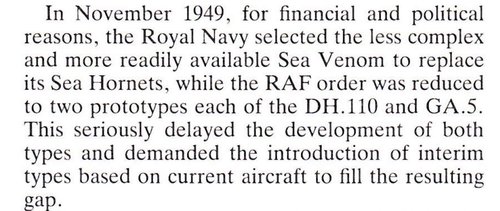I pulled the file from Kew on this last week. As ever it’s a more complicated tale.
The origin of Spec F.5/49 was Operational Requirement OR.234 and associated Spec F.17/47 issued in 1947 for a long-range fighter adapted from the OR.227 (F.4/46) night fighter. At this stage it seems de Havilland, Gloster and Hawker did some design work, but it’s not clear if they were formally submitted. OR.234 seems to have been suspended some time during 1948 but the MoS wrote up F.5/49 in early 1949, and the Air Staff revisited OR.234. It seems this activity was kickstarted by de Havilland's submission of a DH.110 variant to meet OR.234.
The DH.110 design had wingtip fuel tanks (giving 56ft span) and by all accounts a "complicated" fuel system (300gal replacing AI.9c radar, 1,550gal internally, 2x 190gal underwing drop tanks and 2x 200gal wingtip tanks). Cameras could be fitted, the navigator was retained despite removal of the radar. AUW was around 37,000lb, range around 2,700nm. Engines were two Avons.
By February 1950 Issue 2 of OR.234 was ready and de Havilland made a second submission as an "Intruder or Long Range Escort Fighter" the following April. The AI.9c radar was added back in. Gloster submitted a version of the F.4/48 (Javelin) in May with reheated RA.5s. Gloster seems to have only been interested in the high-altitude role. English Electric also submitted a Canberra, basically a PR.3 fuselage with B.2 wings with two RA.3 or Sapphires with reheat, extra integral tansk and optional tip-tanks and increased 61,000lb AUW. The MoS estimated the required AUW to meet the new OR.234 would be 120,000lb!! Typically, the OR had become bloated. The MoS was leaning more towards the Canberra for its load capacity.
Gloster followed up in July offering two more Javelin developments with unreheated Sa.50 Sapphires as high-altitude and all-weather fighters. At the same time, the Air Ministry were thinking of a two-seat intruder and that any long-range fighter would have to be a development of the intruder. Things seem a little murky in the available file, all the proposals seem only to have had cursory examination by the MoS with little in-depth work yet de Havilland had already been issued contracts for two F.5/49 prototypes a year before. The Canberra intruder seemed the best bet and F.5/49 went into abeyance and the two DH.110 prototypes were cancelled that July but work on OR.234 continued. By August the Gloster proposal was favoured but with some reservations. By February 1951 Glosters were looking at various aspect ratios and fuel tankage arrangements to improve performance. The result in April 1951 was a variant with a 66ft span 1,030sq ft area wing, 1,640gal of internal fuel plus 760gals in 2x ventral tanks, AUW 45,700lb. By March 1952 work was still ongoing, work now being more or less merged with that for the OR.309 variant for photo-recon. But with a planned production date of 1958 the RAF was concerned it was a project without value. On 17 September 1952 OR.234 was finally cancelled, a few months earlier Gloster had already been told to ignore OR.324 and focus on the Red Dean equipped all-weather fighter and OR.309 PR developments instead.


